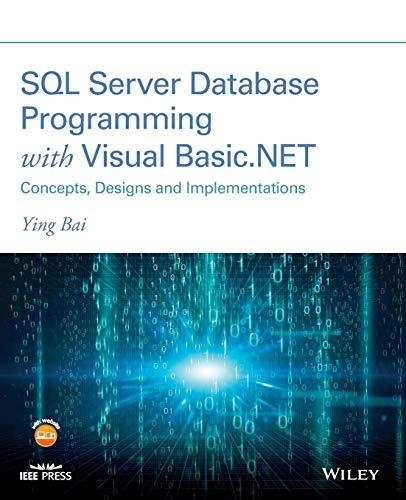Answered step by step
Verified Expert Solution
Question
1 Approved Answer
Write your answers here, or copy and past it here Questions number 4 , 5 , and 6 are similar and must be done according
Write your answers here, or copy and past it here
Questions number and are similar and must be done
according to the example provided in c
Answer Question #
In a Python program that handles user input for numerical data, textual data, and dates, I would use different data types for each. For numerical data, I would use int for integers and float for decimal numbers. For textual data, I would use the str type, and for dates, I would use datetime.date from the datetime module. Type conversion is necessary when dealing with user input, so I would use functions like int and float to convert strings to numbers and datetime.strptime to parse date strings into date objects. Some challenges I might face include users entering data in the wrong format, which can cause errors. To handle this, I would implement tryexcept blocks to catch these errors and provide clear error messages, guiding users to enter the correct format.
Answer Question #
The operator is used for exponentiation in Python, allowing you to raise a number to the power of another number. For example, will result in
The operator in Python performs floor division, which divides two numbers and rounds down to the nearest integer. For instance, results in
Answer Question #
a The operator in Python performs floor division, which divides two numbers and rounds down to the nearest integer. For instance, results in
b To concatenate strings in Python, you use the operator. For example, "Hello, "world!" results in "Hello, world!".
cThe expression and in Python evaluates to False because is True but is False, and both conditions must be True for the and operator to return True.
dThe operator in Python calculates the remainder of a division, known as the modulo operation. For example, results in
e In Python, is the symbol used for the comparison operator "not equal to This evaluates to True if the values on either side of the operator are not equal.
Answer Question #
a The operator can be used for both addition and concatenation in Python. For example, results in and "Hello, "world!" results in "Hello, world!".
b In Python, the operator performs floor division, which means dividing two numbers and rounding down to the nearest integer. For instance, results in
cThe operator is used for exponentiation in Python, allowing you to raise a number to the power of another number. For example, results in
d The operator in Python calculates the remainder of a division, known as the modulo operation. For example, results in
e In Python, is the symbol used for the comparison operator "not equal to This evaluates to True if the values on either side of the operator are not equal.
Answer Question #
aThe operator can be used for both addition and concatenation in Python. For example, results in and "Hello, "world!" results in "Hello, world!".
Step by Step Solution
There are 3 Steps involved in it
Step: 1

Get Instant Access to Expert-Tailored Solutions
See step-by-step solutions with expert insights and AI powered tools for academic success
Step: 2

Step: 3

Ace Your Homework with AI
Get the answers you need in no time with our AI-driven, step-by-step assistance
Get Started


